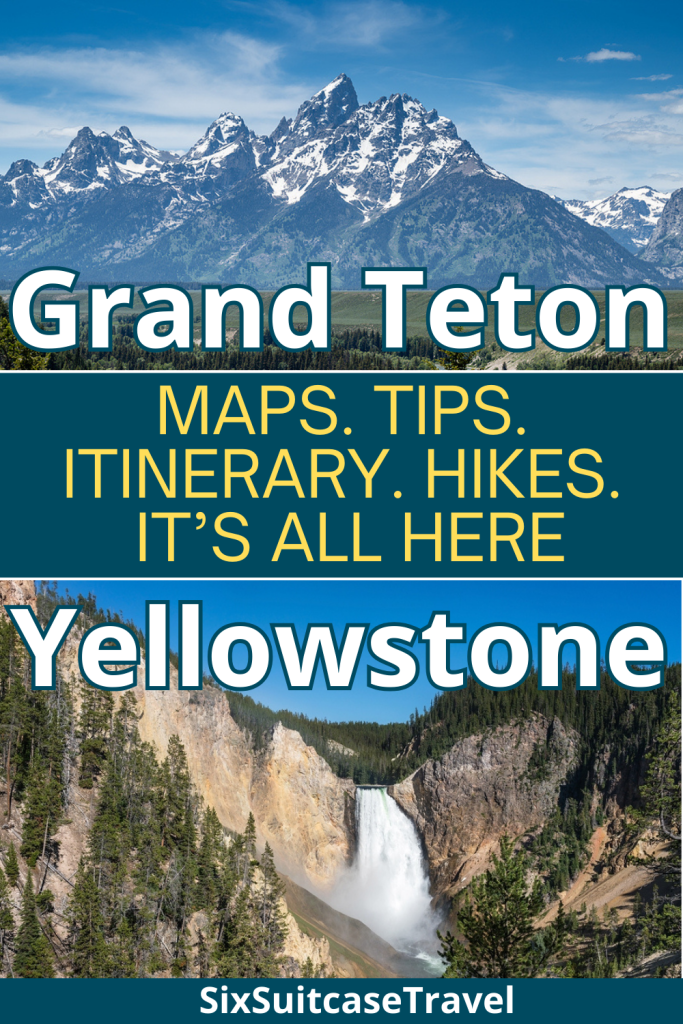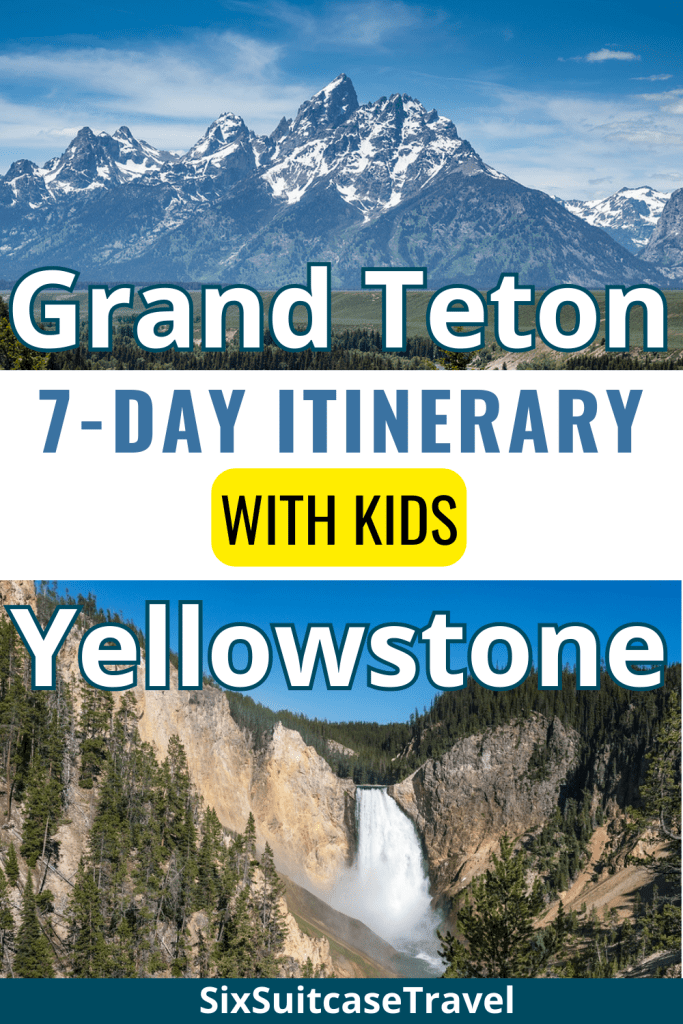Jagged peaks, steaming geysers, wide valleys filled with bison—Grand Teton and Yellowstone are two of the most scenic national parks in the country. From quiet trails along alpine lakes to boardwalks through otherworldly hot springs, the parks are packed with views and experiences you won’t find anywhere else. Visiting both in one trip is not only doable, the parks are about 30 miles apart, it’s one of the best family vacations you can take.
This 7-day itinerary for Grand Teton and Yellowstone National Parks is based on our own family trip through both parks. It’s made for families who want to see the main sights without spending hours in the car each day. We’ve organized each day to cut down on drive time and help you enjoy more of the parks with less backtracking.
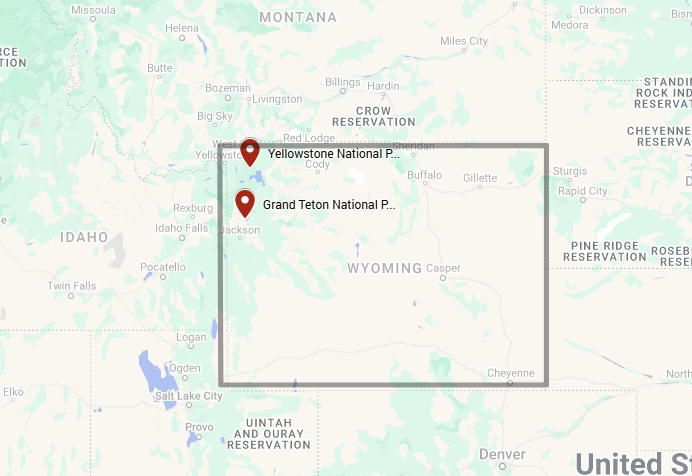
You’ll see mountain views, geysers, hot springs, lakes, wildlife, and more. With easy hikes, scenic drives, and tips for where to stay, this plan works well for first-time visitors or anyone who wants a simple way to visit both parks in one trip.
Before getting into the day-by-day itinerary, be sure to explore all our articles on Grand Teton and Yellowstone. Start with our Grand Teton guide and Yellowstone guide for overviews and tips. We also cover where to hike, which scenic drives to take, and have ten detailed posts that break down each section of Yellowstone’s Grand Loop. These resources can help you build your own trip or adjust this itinerary to fit your schedule.
- Day One: Grand Teton Outer Loop
- Day Two: Grand Teton Inner Loop / Teton Park Road
- Day Three: Grand Teton Lower Loop
- Day Four: Southeast Yellowstone – Grand Canyon of the Yellowstone & Hayden Valley
- Day Five: Southwest Yellowstone – Old Faithful, Geysers & Hot Springs
- Day Six: Northwest Yellowstone – Norris Geyser Basin & Mammoth Hot Springs
- Day Seven: Northeast Yellowstone – Tower Fall and Lamar Valley
- Where to Stay (and Stock Up)
- Use Our Guides to Build Your Dream Itinerary
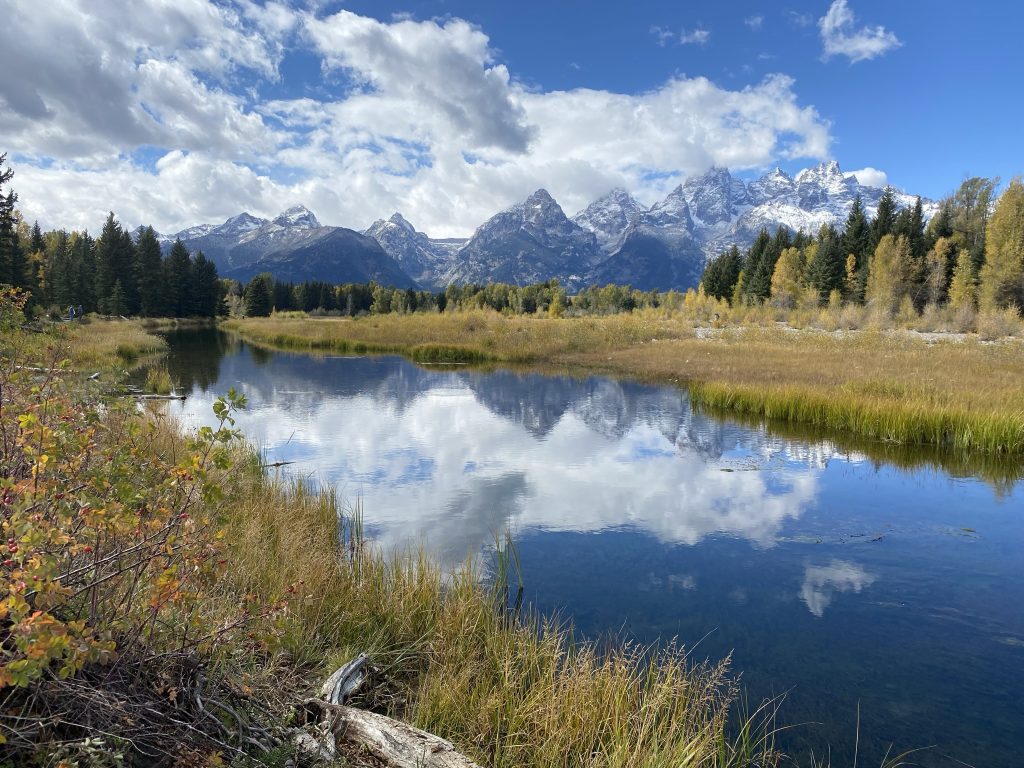
Day One: Grand Teton Outer Loop
Begin your Grand Teton adventure by heading north from Jackson along U.S. Highways 191/89/26, forming the park’s outer loop. This route offers a series of scenic pullouts and historic sites, ideal for short stops to enjoy the views and take photos.
Start at Jackson Lake Lodge, where the lodge’s windows frame the Teton Range and give you a preview of what’s ahead. Then head to Willow Flats Overlook for wide-open views of Jackson Lake. Continue to Oxbow Bend Turnout, where Mount Moran reflects in the Snake River. It’s one of the park’s most photogenic scenes.
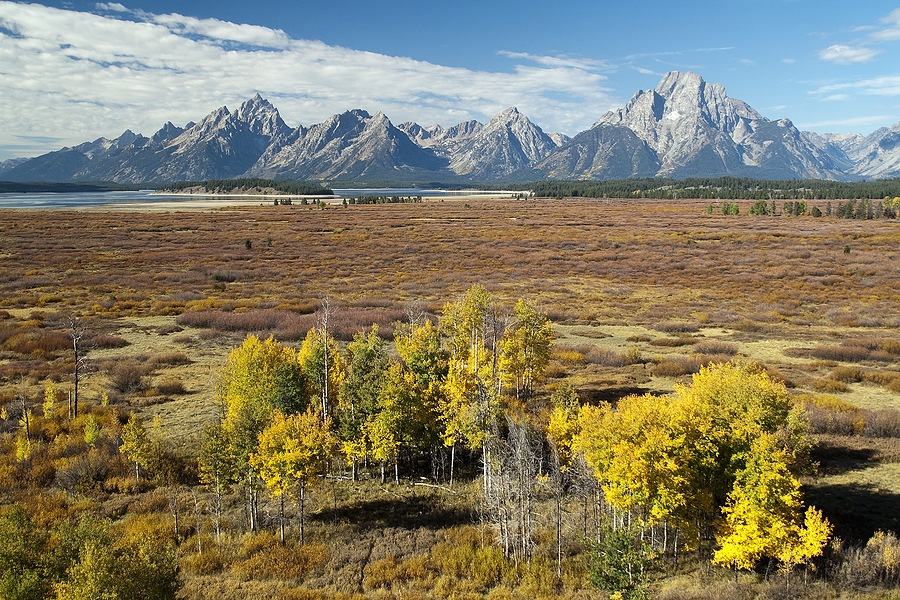
Next, visit the river access at Moran Junction and stop at Elk Ranch Flats Turnout for sweeping grassland views. The historic Cunningham Cabin offers a look at early homesteading in the area. A quick detour down Deadmans Bar Road brings you to a quiet river spot.
Make time for the Snake River Overlook, famously photographed by Ansel Adams, then continue to Teton Point Turnout. Don’t miss Schwabacher Landing—a peaceful riverside walk and one of the most scenic spots in the park. Finish the day with stops at Glacier View Turnout and Blacktail Ponds Overlook for more dramatic mountain and valley scenes.
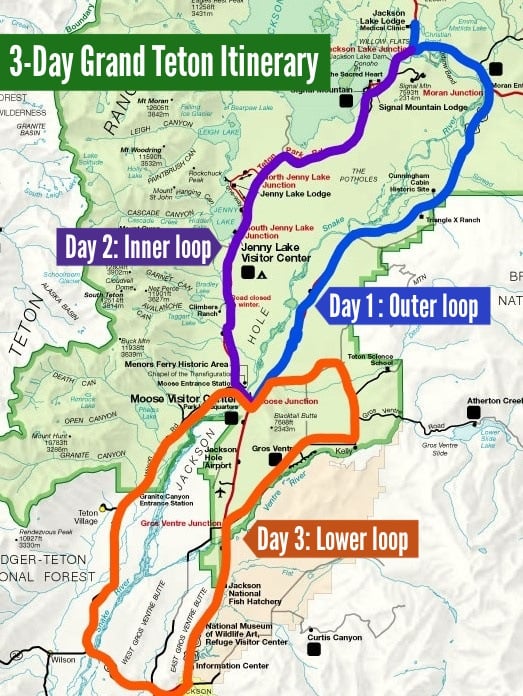
Day Two: Grand Teton Inner Loop / Teton Park Road
Explore the park’s inner loop via Teton Park Road, starting from Moose Junction. Begin at the Menors Ferry Historic District and the Chapel of the Transfiguration, where historic buildings meet impressive views.
The Taggart Lake Trailhead offers hike options from 3 to nearly 6 miles round trip. Stop at the Teton Glacier Turnout for a look at the park’s largest glacier. A short wooden bridge leads to either Lupine Meadows Trailhead or a Jenny Lake boat launch.
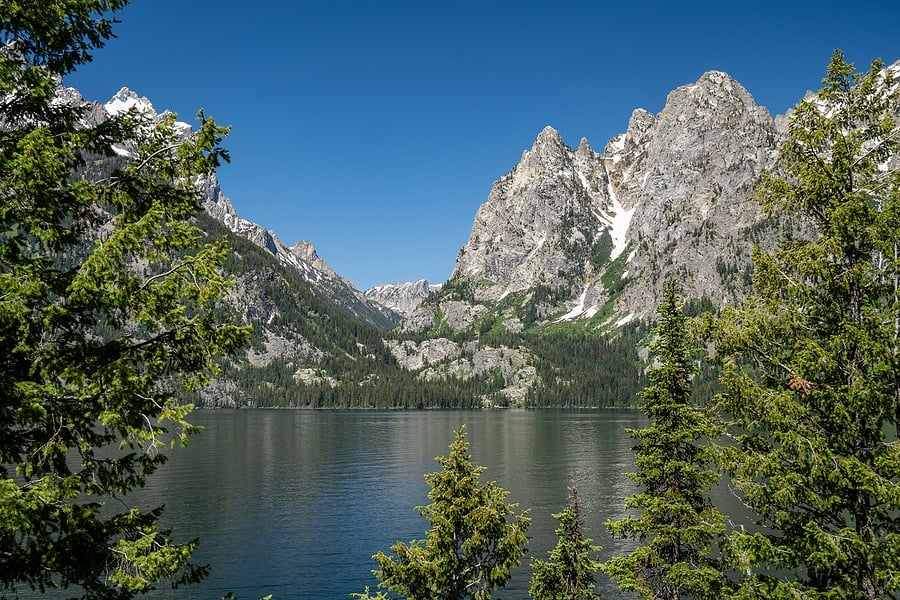
At Jenny Lake, visit the small visitor center in a historic cabin. Take the one-way Jenny Lake Scenic Drive and stop at Cathedral Group Turnout, Leigh Lake Trailhead, String Lake Trailhead, Jenny Lake Lodge, and Jenny Lake Overlook for varied perspectives on the landscape.
Further north, stop at Mount Moran Turnout and Potholes Turnout before reaching Signal Mountain Lodge. A drive up Signal Mountain Road offers panoramic views. Then see the Chapel of the Sacred Heart and the historic Jackson Lake Dam. Finish the day back at Jackson Lake Lodge.
Day Three: Grand Teton Lower Loop
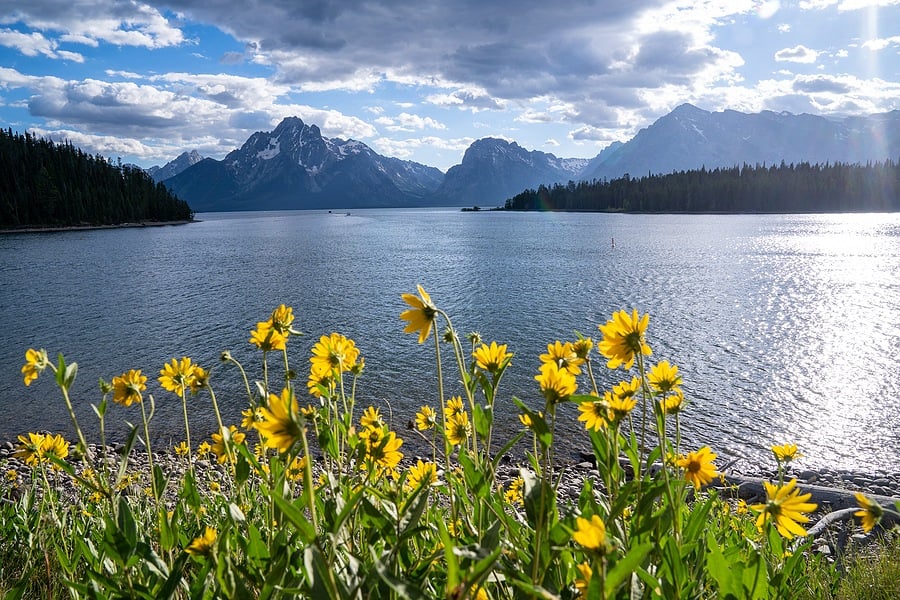
Start your day early in Jackson and drive north to Gros Ventre Junction to begin the eastern loop. This area is a good place to see bison, moose, or even bears. Drive through Kelly and follow Lower Gros Ventre Road onto Antelope Flats Road. After turning west, you’ll reach the Mormon Row Historic District and its iconic Moulton Barns.

Head back to Highway 191/89/26 and turn south toward Moose Junction. If you’re making good time, revisit Jenny Lake and take the shuttle boat across to access the hike to Hidden Falls and Inspiration Point. The shuttle saves you four miles of walking round-trip.
Continue south on Teton Park Road to Moose-Wilson Road. This scenic drive leads to Teton Village and the Jackson Hole Mountain Resort. Ride the Aerial Tram or Gondola to the top for amazing valley views. At the summit, stop at Corbet’s Cabin for waffles or grab pizza at Off Piste Market. Return to Jackson via Highway 22 to wrap up your time in Grand Teton or continue on to lodging between the Grand Teton and Yellowstone.
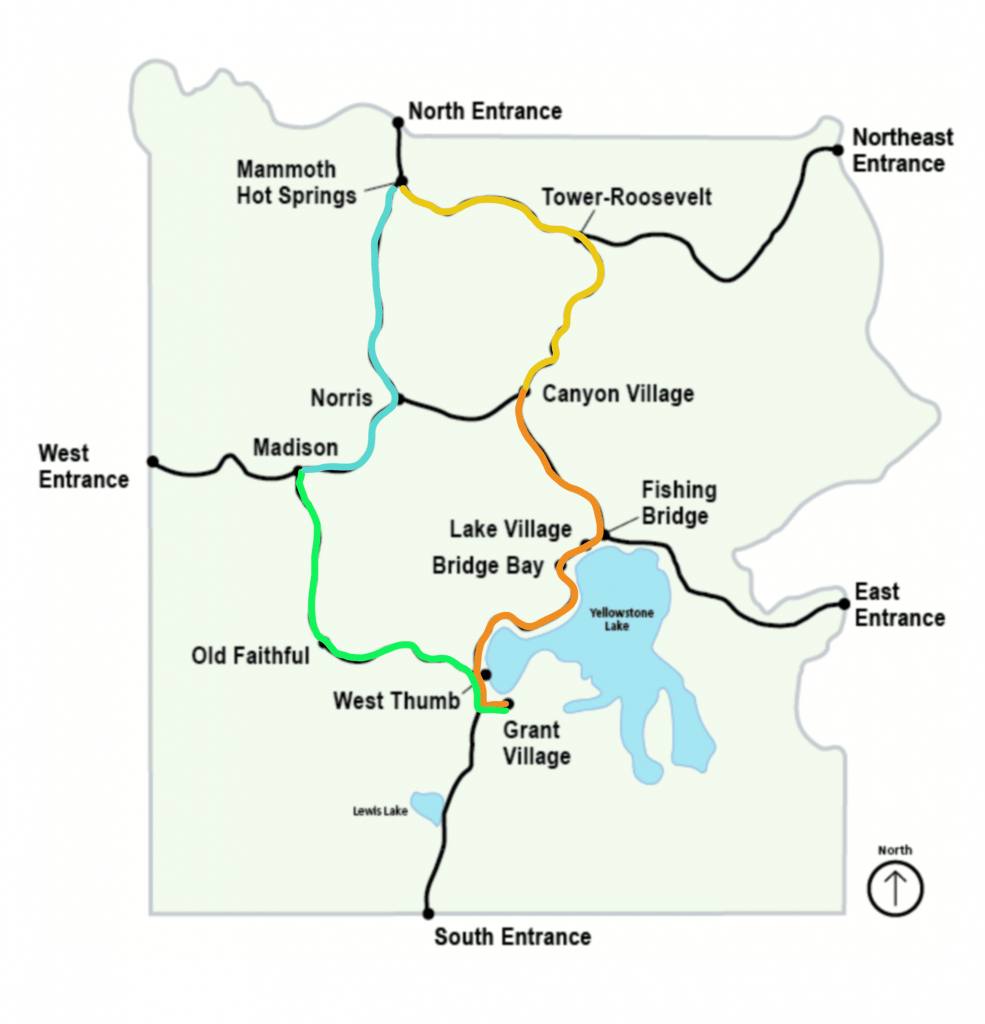
Day Four: Southeast Yellowstone – Grand Canyon of the Yellowstone & Hayden Valley
Start your Yellowstone experience with one of the park’s most striking landscapes, the Grand Canyon of the Yellowstone, my favorite area of the park. This colorful canyon stretches over 20 miles and reaches depths of 1,200 feet, with the Yellowstone River cutting through its center. Several overlooks and short trails give you different views of the canyon and its famous waterfalls. Many stops are close together, so it’s easy to see several viewpoints in a single visit.
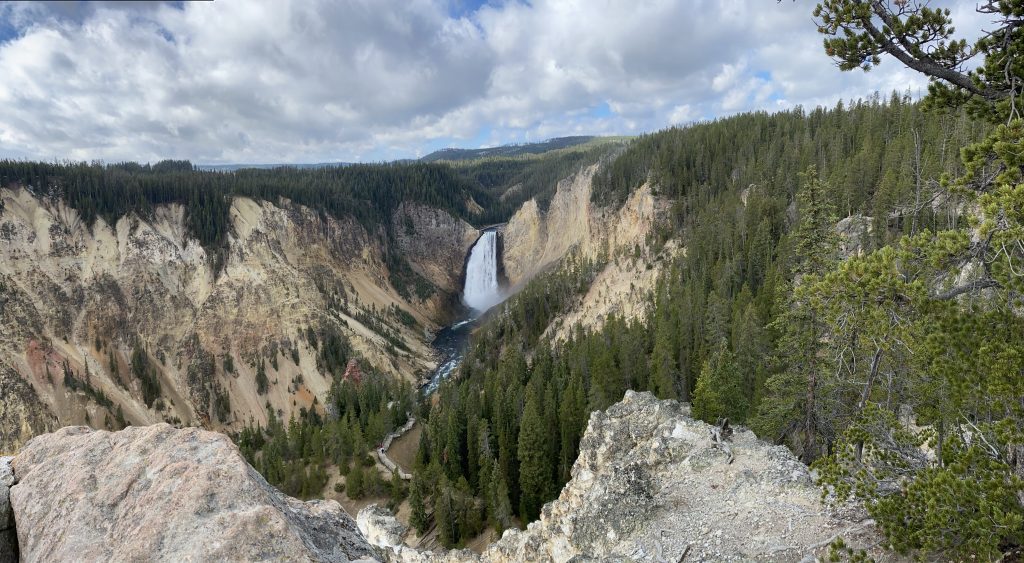
Artist Point is the most popular and photogenic stop. From here, you’ll see the Lower Falls perfectly framed by the canyon’s golden and rust-colored rock walls. It’s one of the best places in the park for a family photo. The viewpoint is a short walk from the parking lot and suitable for all ages.
The Brink of the Lower Falls Trail takes you to the very top of the falls. The trail is just 0.7 miles round-trip but includes a steep descent and climb back. The reward is a dramatic, up-close view of the falls crashing over the edge—it’s loud, windy, and unforgettable. This trail is best for families with older kids who can handle the grade and want to get close to the action.
Lookout Point offers a different angle of the Lower Falls, perfect if you want a stunning view without the hike. Just below it, Red Rock Point requires a short but steep trail down to a lower platform for an even closer view of the waterfall. It’s a great alternative to Uncle Tom’s Trail if you want something less intense but still adventurous.
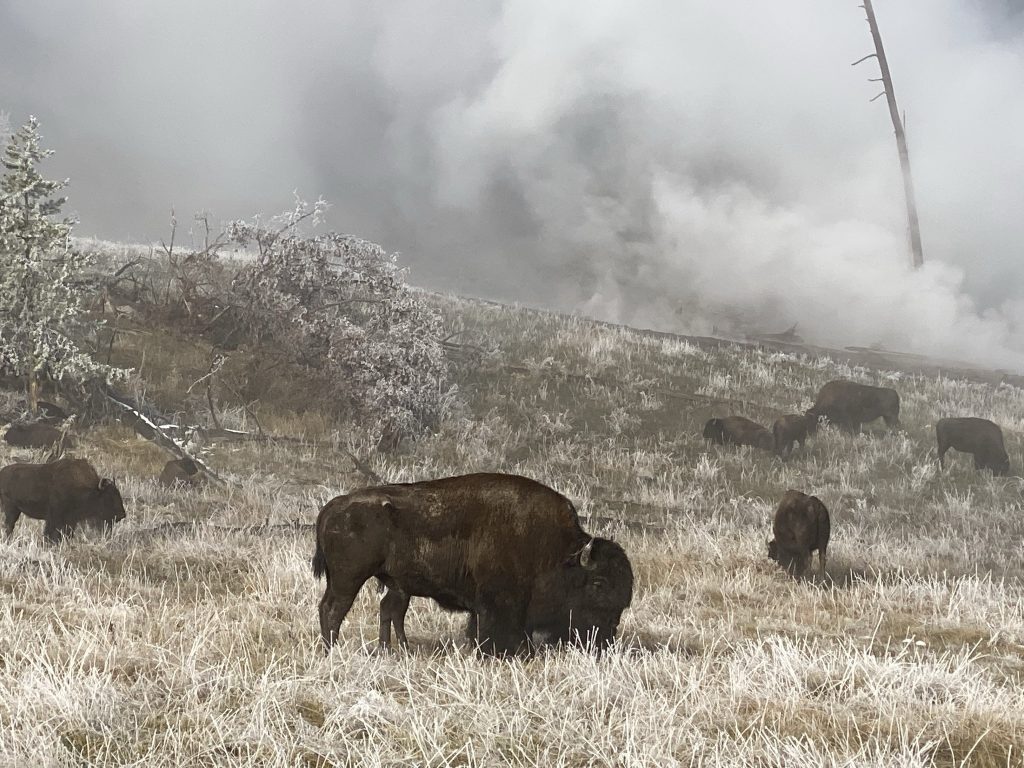
In the afternoon, head south to Hayden Valley, one of the best places in the park to see wildlife. Bison are commonly seen grazing near the river, and you might spot elk or even a bear from one of the roadside pullouts. Bring binoculars and take your time. Early mornings and evenings are best for sightings, but even midday can be productive. Wrap up the day with a stop at Mud Volcano and Sulphur Caldron—both have short boardwalk trails with boiling mud pots and steaming vents.
Day Five: Southwest Yellowstone – Old Faithful, Geysers & Hot Springs
Day five focuses on Yellowstone’s southwest section, home to some of the most famous thermal features in the world. Start your morning at West Thumb Geyser Basin, a quieter stop with colorful pools and lakeside geysers right on the edge of Yellowstone Lake.
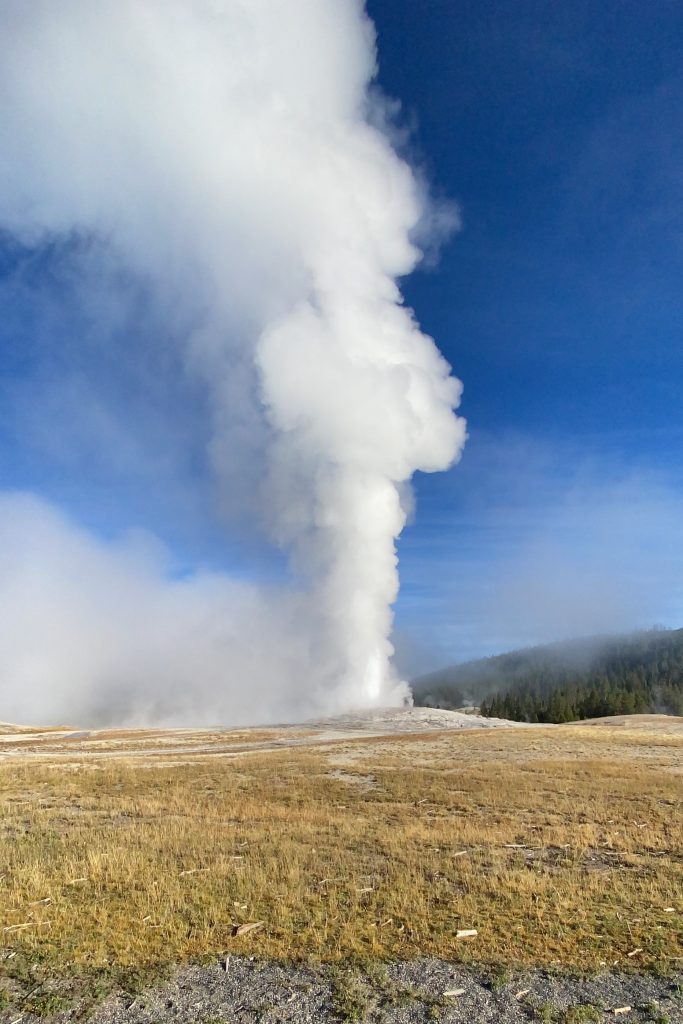
Then make your way to the Upper Geyser Basin and Old Faithful. The visitor center posts eruption times for major geysers in the area, including Old Faithful (approximately every 90 minutes), Grand Geyser, Riverside Geyser, and Castle Geyser. If you can time it right, Grand Geyser is especially impressive—its eruption can last up to 12 minutes and shoot over 150 feet in the air.
After watching Old Faithful, take the boardwalk trails through the Upper Geyser Basin. Plan about 2 hours to explore this area on foot, depending on how many geysers you want to wait for. The paths are mostly flat and well-maintained. While not all trails are stroller-friendly, many families find umbrella strollers manageable—just be mindful of the occasional bump or step.
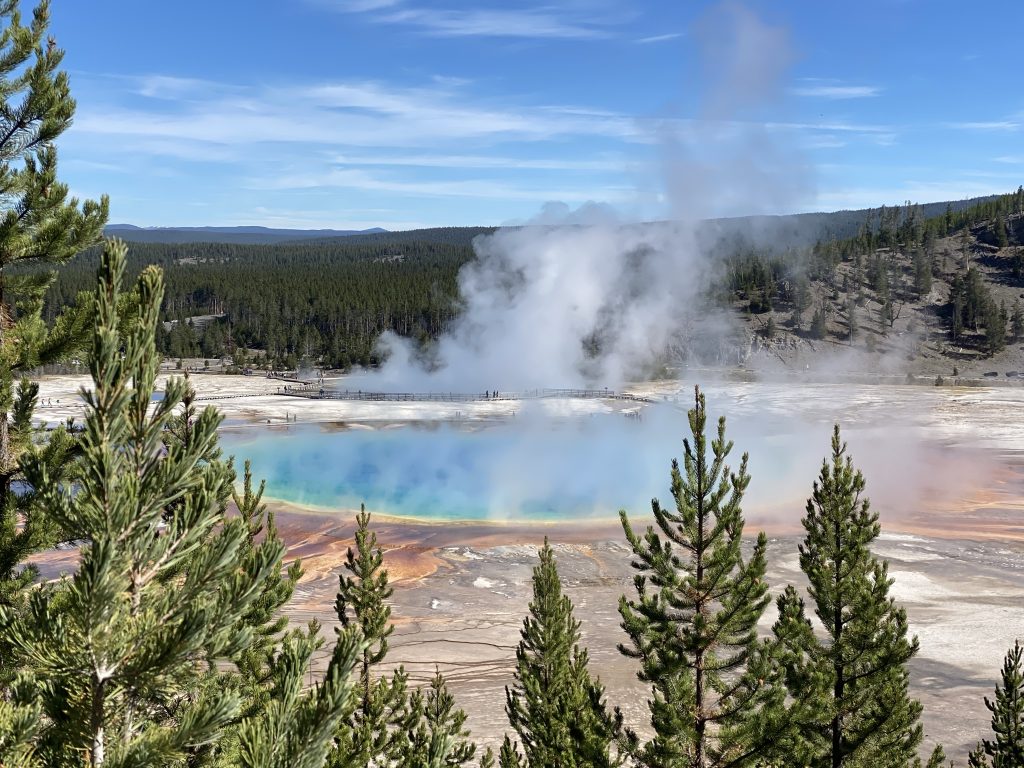
Later in the day, head north to the Midway Geyser Basin. This is where you’ll find Grand Prismatic Spring, Yellowstone’s most colorful and recognizable hot spring. Walk the boardwalk to view the spring up close, then drive a few minutes north to the Fairy Falls Trail parking lot to access the overlook. The hike to the overlook is about 0.6 miles one way on a wide, gravel trail. It’s slightly uphill but doable for most families, and the view from above is worth the effort.
Don’t skip Excelsior Geyser Crater while you’re in Midway. Once an erupting geyser, it’s now a massive hot spring that pours 4,000 gallons of water into the Firehole River every minute. Nearby, Turquoise Pool and Opal Pool round out this small but spectacular basin.
Finish your day in the Old Faithful area or nearby Madison Junction, depending on where you’ve booked your stay. This region offers a full day of activity without needing to drive far between stops.
Day Six: Northwest Yellowstone – Norris Geyser Basin & Mammoth Hot Springs
Day six covers the northwest section of Yellowstone, beginning with Norris Geyser Basin—one of the hottest, most acidic, and most active geothermal areas in the park. This area is divided into two sections: Porcelain Basin and Back Basin, each with its own character.
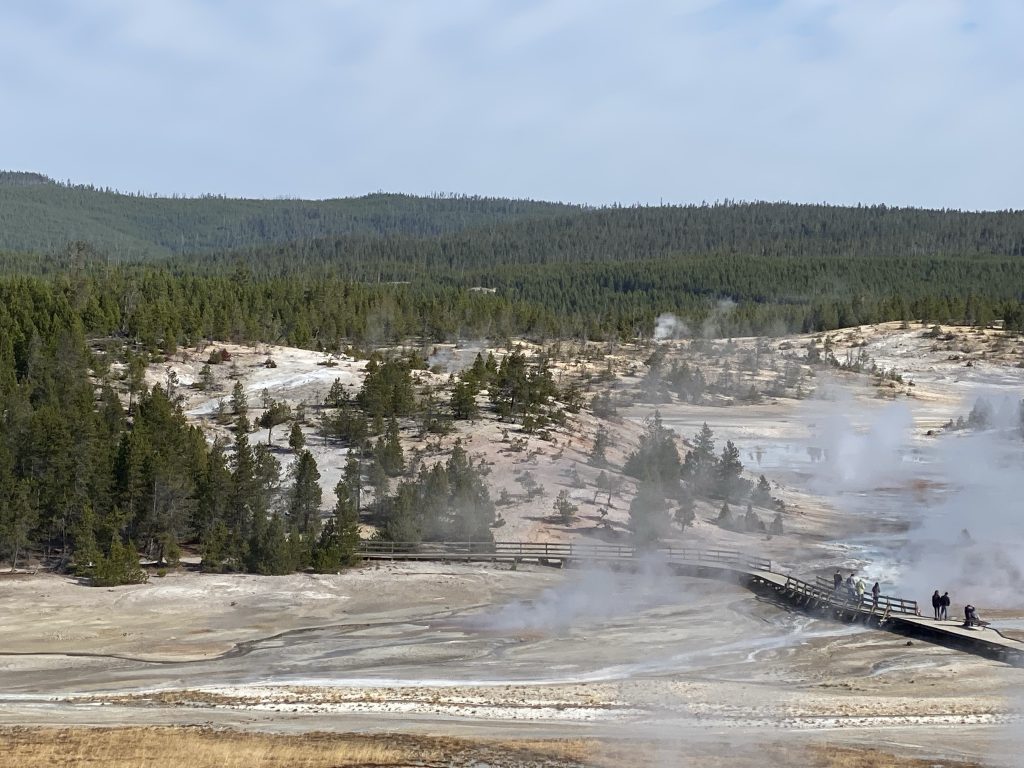
Porcelain Basin features an open landscape of steaming vents and mineral-covered ground, with a short loop trail that takes about 30 minutes. It’s a good first stop for families with younger kids due to its flat, wide boardwalk. The Back Basin loop is about 1.5 miles and takes around 60–90 minutes to walk. Here you’ll find Steamboat Geyser, the tallest active geyser in the world, though it erupts unpredictably. Echinus Geyser is another key feature, once one of the few acid geysers in the world that erupted regularly.
Norris is a great place for older kids and teens who are curious about science. It’s one of the most geologically dynamic spots in Yellowstone, and the visitor information panels explain the chemistry, heat flow, and changes happening beneath the surface. Temperatures in some parts of Norris can exceed the boiling point of water, making it a fascinating and eye-opening place to learn.
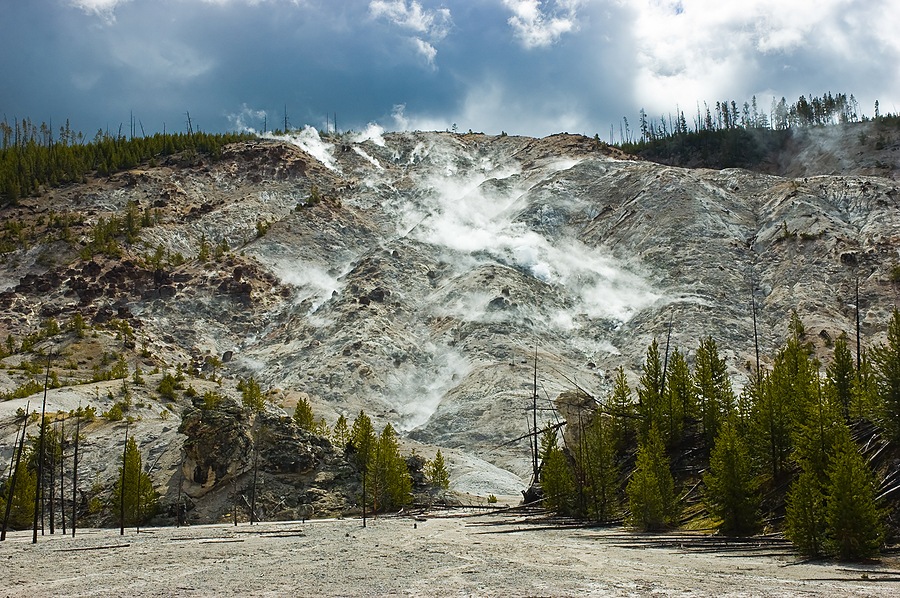
After Norris, continue north to Mammoth Hot Springs. Start at the Lower Terraces, where features like Liberty Cap and Palette Spring offer some of the most photographed views in the park. The walkway climbs gently, but it’s worth it to explore the different levels. If mobility or time is a concern, you can also drive to the Upper Terraces and stop at scenic pullouts for quick photos and views of the active formations from above.
While in Mammoth, plan a stop at the Albright Visitor Center to learn about Yellowstone’s history and wildlife. If the timing works, take a short detour to the Boiling River, a spot where a hot spring mixes with the cold Gardner River. Though swimming isn’t always permitted, dipping your feet in the warm water can be a fun, relaxing break.
Stay the night in Gardiner or Mammoth. Elk often wander through the area in the evenings, and the quiet, open surroundings make a peaceful end to the day.
Day Seven: Northeast Yellowstone – Tower Fall and Lamar Valley
On your final day in Yellowstone, explore the park’s northeastern corner, which is known for its dramatic scenery and excellent wildlife viewing. Start at Tower Fall, a 132-foot waterfall framed by tall volcanic spires. There’s a short, paved trail from the parking lot to a viewpoint overlooking the falls that’s suitable for younger kids. The area also has restrooms, a general store, and a small overlook of the canyon—an easy stop with big payoff.
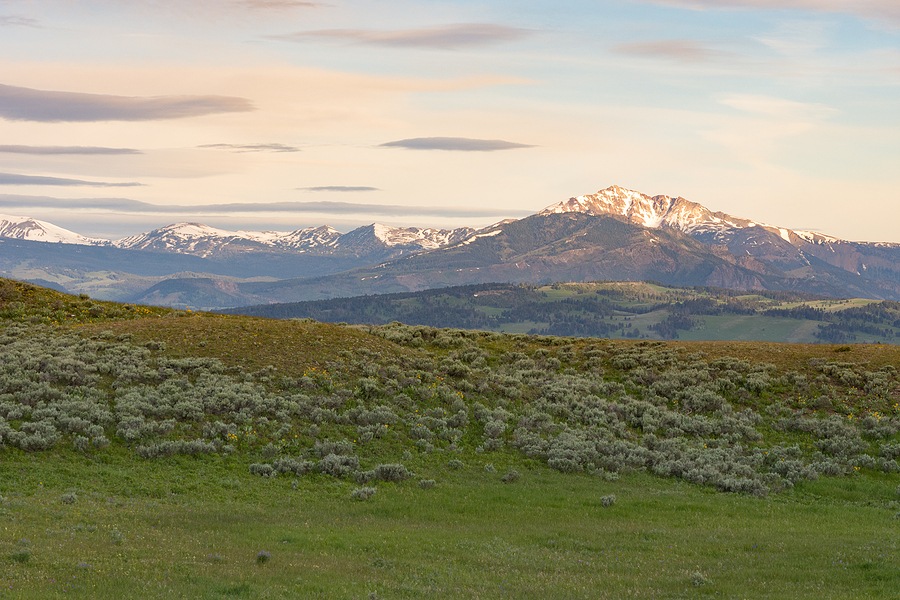
As you head east toward Lamar Valley, consider a quick detour onto Blacktail Plateau Drive. This one-way, gravel road offers quieter scenery and the chance to spot wildlife away from the main loop. If your group is up for a short hike, the Lost Lake Loop near Roosevelt Lodge is a moderate 2.8-mile trail through forests and meadows, often overlooked by crowds. Another good option is the Trout Lake Trail—a short but steep 1.2-mile round-trip hike to a peaceful alpine lake that’s popular with photographers and offers great wildlife viewing in the early morning or evening.
Lamar Valley is often called “Yellowstone’s Serengeti” for good reason. This wide, open valley supports massive herds of bison, elk, and pronghorn, as well as predators like wolves and bears. Look for groups of people with spotting scopes—these are usually wildlife watchers who’ve found something interesting. The best times for sightings are early morning and late evening, when animals are more active and temperatures are cooler. Bring binoculars, pack some snacks, and be ready to pull over at multiple spots along the road.
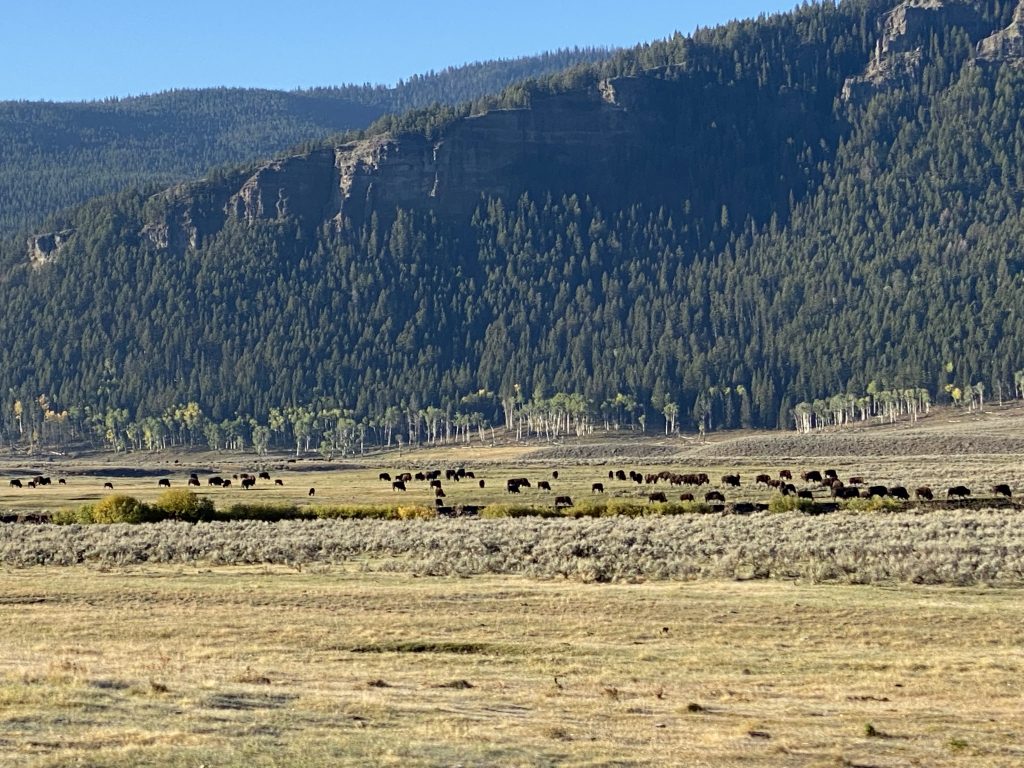
For safety, always view wildlife from a distance—at least 100 yards for bears and wolves, and 25 yards for bison and elk. Never approach animals, even if they seem calm, and always keep kids close in areas known for wildlife activity.
Wrap up your trip in Cooke City for a quick look at this tiny mountain town before turning back, or head back toward Gardiner for your final night. Either way, the northeast section offers a quieter, less visited side of Yellowstone to end your week on a high note.
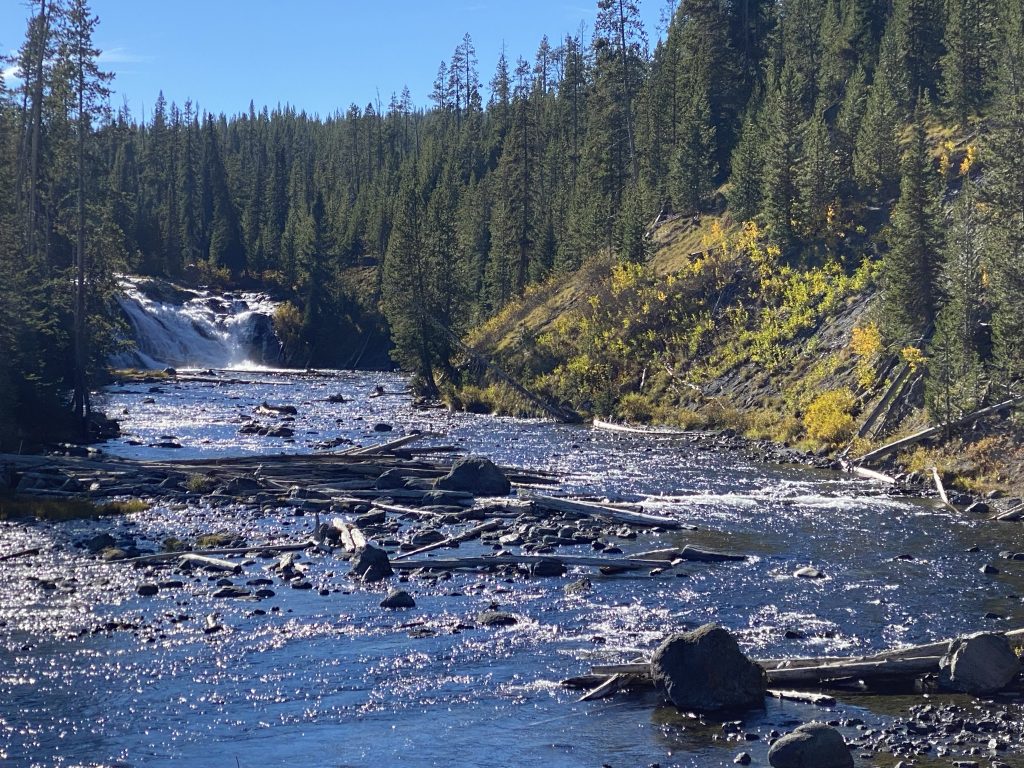
Where to Stay (and Stock Up)
To make the most of your time in Grand Teton and Yellowstone, consider booking hotel rooms or cabins at different locations around the parks. Staying in multiple spots helps reduce drive time and makes it easier to explore each area at a relaxed pace—especially when traveling with kids. The following route pairs lodging recommendations with convenient places to restock supplies along the way.
Jackson, Wyoming
Start your trip in Jackson, a charming western town with plenty of lodging, restaurants, and shops. It’s the best place to prepare before heading into the parks. Jackson has a full-size Albertsons grocery store, perfect for loading up on snacks, drinks, and picnic items. You’ll also find outdoor gear shops and restaurants suitable for families.
Colter Bay Village (Grand Teton)
For your time in Grand Teton, consider staying at Colter Bay Village near Jackson Lake. It’s close to hiking trails and scenic turnouts and offers a quieter, more immersive national park experience. The village has a general store for basic groceries and camping supplies, but options are limited—plan to bring what you need from Jackson.
West Yellowstone, Montana
As you move north into Yellowstone, staying in West Yellowstone is ideal for exploring the geyser basins and Old Faithful area. This town is just outside the west entrance and has a good selection of hotels and eateries. Stock up at one of two grocery options: Food Roundup Supermarket or Market Place, both located on Canyon Street. These stores carry a solid selection of groceries and essentials for families on the go.
Gardiner, Montana
End your trip with a stay in Gardiner, near Yellowstone’s north entrance. This location makes it easy to access Mammoth Hot Springs and Lamar Valley. For supplies, visit Gardiner Market—a local grocery store with produce, snacks, and ready-to-eat options. It’s smaller than what you’ll find in Jackson or West Yellowstone, but convenient for final-day needs.
Booking your lodging in a loop like this keeps drive times manageable and lets you focus on the sights instead of spending hours in the car. Be sure to reserve accommodations early, especially if you’re visiting in summer or traveling with a big group.
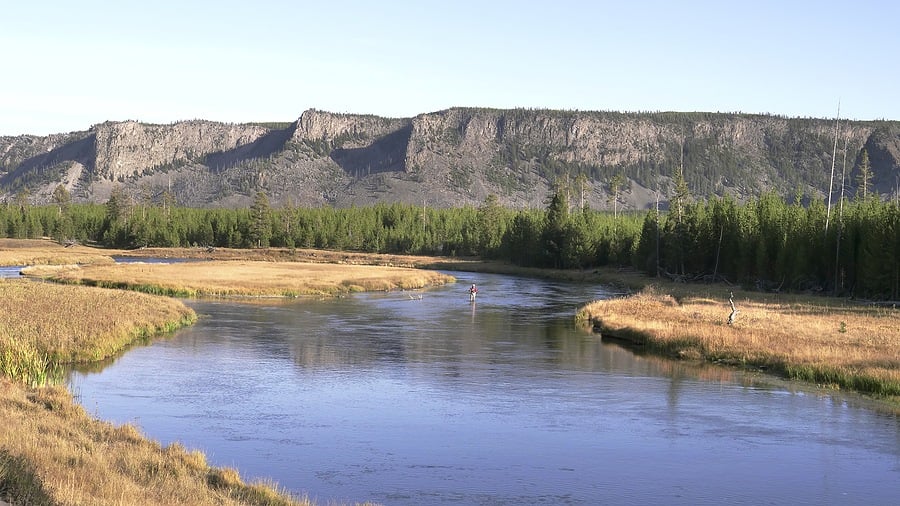
Use Our Guides to Build Your Dream Itinerary
You can adjust this 7-day plan to fit your travel style. If you only need two days for the Grand Teton, you can add an extra day in Yellowstone. Or if you’re just passing through the area, use the detailed daily guides linked throughout this post to build your own route. Whether you’re planning a full week or a shorter visit, the goal is the same—see more and drive less.

